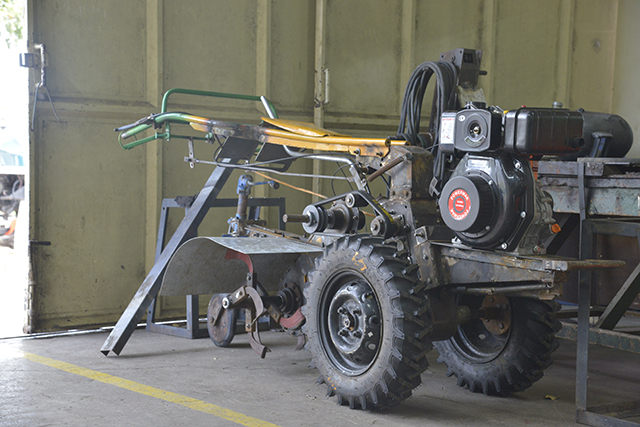
PhilRice’s gear-type transmission power tiller is a multi-purpose machine that can be used as a hauler, rotavator, transplanter, seeder, and multi-seeder. The machine is still under development and will undergo a series of tests this year.
The Philippine Rice Research Institute (PhilRice) will soon release a first of its kind, locally made two-in-one machine that can be used for land preparation and crop establishment.
What’s the difference?
Dr. Arnold S. Juliano, head of PhilRice Rice Engineering and Mechanization Division, said that the power tiller is a multi-purpose machine that can be used as a rotavator, transplanter, seeder, and a multi-seeder for those involved in multi-cropping. It can also be used for hauling when attached with a trailer. The method of cultivation is also changeable for land preparation depending on the planting season (wet or dry). Moreover, this power tiller can directly turn 180 degrees unlike those already available in the local market.
Aside from the many purposes it can serve, the machine is very cost-effective. It uses an engine with lower horsepower (hp) than the usual power tillers which translates to less fuel consumption.
“Let us say a hand tractor costs P100,000 and a transplanter costs P350,000. When you combine these machines, you will only need to buy the attachment and not the whole machine. Suppose the transplanter attachment is only P70,000 plus the hand tractor, it will only cost you P170,000 against P450,000. That is more than 50% savings,” Juliano explained.
He affirmed “it is a huge saving because the farmer will only buy one machine with multiple applications.”
Expect for more
According to Juliano, mechanization is pushing itself through the agriculture industry especially on rice. Farmers will have to embrace the use of machines or be left behind.
“We can do nothing about it. We are going there,” Juliano stated.
He further highlighted the need to develop local machines and be independent from importation. Currently, the country is largely reliant on farm machines from other countries. This makes acquisition and repair more difficult brought about by high prices and availability of parts.
“We should think of machines that will help lower our farmers’ expenses. Not just one application but we can add more in one machine to reduce operational cost. Of course, one machine will be cheaper,” he added.
Way ahead
Farm mechanization is without a doubt one of the best strategies to become competitive and resilient to the adverse impacts of natural disasters. However, for a typical Filipino farmer, this could mean additional cost. There are the soaring prices of machines, which are deemed too high for the average annual income of a rice farming household.
The gear-type transmission power tiller will definitely be a cost saver. But, still it has to undergo a series of tests later this year before finally reaching the hands of the farmers. Its developers at PhilRice are hopeful for its release the soonest possible.
“We are thinking of how to fast-track the process,” Juliano asserted.




